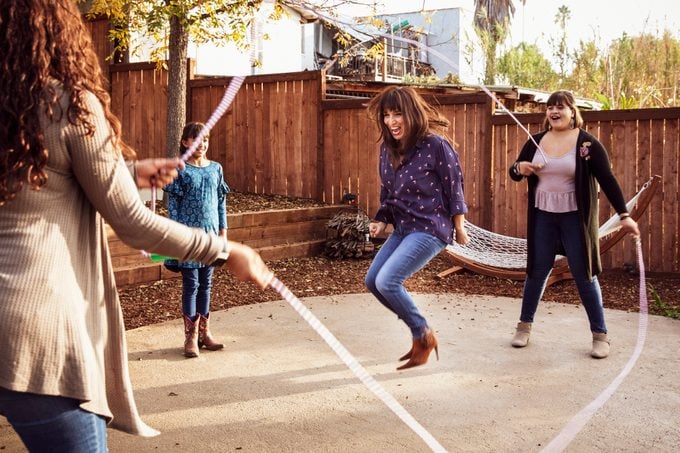38 Fun Ways to Have a Healthier and More Active Family
Updated: Mar. 14, 2022
Put down the remote and start dancing, planting, and walking with your kids. Here are dozens of ways to have healthy fun with your family.

Engaging your kids in a health-promoting lifestyle should be a priority for every loving parent. But if you want trim and healthy kids, you have to get trim and healthy yourself. Studies show that family environment is one of the strongest predictors of childhood obesity. In one study, children of sedentary parents (aka couch potatoes) were more likely to gain weight and become overweight than children of active parents.
Some of the suggestions here may seem too easy to be considered exercise. But remember: You and your child burn more calories standing than sitting, walking than standing. The more you move, the more you burn. It doesn’t matter how wacky your antics, if you are moving and having fun, you’re burning calories and getting in shape. It’s that simple.
1. Go on a treasure hunt. Here’s a great way to keep the family fit and teach your kids about trust, teamwork, and problem solving at the same time. Take them to a local park and set an expedition course on a map, circling various “checkpoints.” Take turns navigating to each point on the map and leading the team to each destination. “Start out with an easy course in an open park and then progress to a trail system,” suggests Jenny Hadfield, a Chicago-based fitness coach and author of Marathoning for Mortals. “Stay together and explore terrain features, study map clues, and look for the secret treasure.” Sound too complicated? Then merely go hunting for bugs, animals, or flowers. You can’t entertain a young kid much better than finding a colorful salamander under a log or rock.
2. Plan 10-minute spurts of activity followed by 5-minute rest periods. Don’t force your adult exercise program on your children. That’s a recipe for disaster. Studies published in the journal Translational Journal of the American College of Sports Medicine show that forcing children to participate in structured exercise turns them off to exercise later in life. Instead, take advantage of their natural tendency to participate in intermittent and sporadic play and exercise bouts. A game of tag is a perfect example. Children’s bodies are designed to sprint and rest, sprint and rest. Because they are easily distracted and incapable of long periods of focused activity, they will resist long exercise sessions that don’t include rest periods.
3. Train for school fitness tests as a family. Learn which fitness tests your child is required to pass in physical education class and train for them as a family. Set goals, such as running a quarter-mile and then a half and then a full mile in a certain amount of time—and reward each family member for meeting each goal.
4. Play follow the leader. Line up single file and weave your way through the house or backyard. Every few steps, hop, skip, do the grapevine or some other movement that your followers must imitate. Once the kids get the hang of the game, let them take turns as leader. Their naturally creative minds will come up with all sorts of fun movements for the followers to imitate. You’ll be out of breath before you know it.
5. Find some family-friendly aerobics workouts for cold or rainy days. Choose workouts that are “low intensity” or “low impact” says Melinda S. Sothern, Ph.D., director of the Prevention of Childhood Obesity Lab at Louisiana State University in Baton Rouge and author of Trim Kids. These types of aerobic exercise are better for children’s developing bodies. Good options include Elmocize, Workout with Mommy and Me, the Richard Simmons series, YogaKids, and Tae Bo Junior.
6. Give your child a head start—and race around the house. You can do the same with calisthenics. You do 10 crunches, and your child does 5. See who can complete them first.
7. Spend an hour doing yard work together. Raking leaves, pulling weeds, and spreading out mulch all help to build strength and endurance. Plus, when your kids help, it doesn’t take as long or seem as much of a chore (depending on the age of the child, of course). There are numerous ways to make yard work more fun for kids. For instance, when you finish raking a pile of leaves, you get to jump in them.
8. Wash the car together. The scrubbing is good exercise, but everyone getting wet and soapy is just plain fun for kids.
9. Give your kids a list of indoor chores—then join them. Younger children often like to feel helpful and will enjoy helping you with household chores. Ask them to help you make the beds, fold the laundry and put it away, set the table, and put dishes in the dishwasher—all physical activities that can help get your heart rate up, stretch your body, and build your
muscles.

10. Plan a garden together. As you dig holes, plant seeds, and pull weeds, you’ll build your child’s and your upper body strength. As an added bonus, children are more likely to eat the vegetables they help grow, which means your gardening forays will help your child follow a more nutritious diet.
11. Take a hike at least twice a month. Grab a backpack, plenty of water (everyone should drink about 8 ounces every half-hour), and a light lunch and head to a local trail for a hiking expedition. Wear hiking boots for rocky terrain or sneakers for smoother trails, and pack sunscreen and insect repellent. To make this more fun for kids, make it about something else, such as looking for a particular animal or bird, climbing to see a lake or pond, or seeing how many rocks you can scamper over without touching the ground. Kids like hiking much better when they don’t realize it’s about hiking! Pack a picnic lunch, of course; this is a great opportunity to share a delicious but healthful meal and cultivate good family eating habits.
12. Dance during commercial breaks. Make it a family rule that whenever you watch television, you have to stand up and dance around during the commercials. This goes for everyone! Whoever gets caught sitting on the couch during a commercial break must perform his or her least-liked household chore for one week.
13. Sign up for a race. Check around for a list of 5K and 10K walk/run events in your area. Many of these events also raise money for charity, which can inspire your children to train for the event. “You’ll not only contribute to your family’s health, but also to research to help find cures for many diseases,” says Dr. Sothern. Don’t worry about finishing; the motivation involved in training for it is enough on its own.
14. Play volleyball once a week in warm weather. Set up a net, get a ball, and you can get in even more fitness if you add these rules:
- When the opposing team scores a point, the receiving team must do 10 calisthenic moves, such as jumping jacks, push-ups, or crunches.
- Whoever is responsible for fumbling a shot must walk, dance, skip, or jog around the court.
15. Try a family-friendly game of flag football. Purchase table napkins in two colors. Divide your family into two teams and ask everyone to tuck one of the colored napkins into their waistband. When an opposing team member pulls a napkin from the ball carrier’s waistband and places it on the ground, the play has ended. Allow only 20 seconds to prepare for kickoff and 10 seconds after a down. Switch positions every 15 minutes to keep the entire family active. Not only will you get in some family fitness time, but you’ll also be teaching your children valuable lessons about practice, perseverance, cooperation, and teamwork.
16. Dance, dance, dance. Put on your favorite music and dance with your children. Teach your children dance moves from your generation and have them show you moves from theirs (or make up moves for you to try). Vigorous dancing burns just as many calories as brisk walking or playing basketball. And kids love it—particularly when the grown-ups pick them up and swing them around every now and then. And don’t just leave dancing to chance, or when you happen to be in the mood—make sure to have one or two family dance sessions a week. Perhaps a Friday night dance can become family tradition. Let everyone choose some of the music, play it in turns, and shake that thang!
17. Make like an animal. If you have young children ages 3-8, organize an animal race. Let everyone in the family pick an animal, such as a snake, monkey, or crab. Then race across the room as you imitate how that animal might move. For example, if you choose a monkey, you must race using your hands and feet, but not your knees or torso. If you are imitating a snake, you must slither across the room. Add some proper animal noises for real fun. You’ll be out of breath before you know it.
18. Walk around the world. Place a map of the country, state, or world somewhere prominently in your home. Work with your children to arrive at a walking destination. Then, based on your daily family walks, plot your progress on the map using thumbtacks. There are about 2,000 steps in a mile, so you can plot your progress by using a pedometer or the fitness tracker on your phone.
19. Start a ball fight. A large, air-filled stability ball can provide you and your children with plenty of fun, laughter, and a great workout, says Liz Applegate, PhD, author of Bounce Your Body Beautiful. Applegate suggests the following ball exercises.
- Stand facing your child with the ball between you. You should both grasp the ball about chest level. This may mean you need to get on your knees depending on the height of your child. Then fight over the ball, rotating it from side to side for 15-20 seconds at a time.
- Stand holding the ball at chest level with your arms extended. Ask your child to try to knock the ball out of your hands by tapping different parts of it from different directions. To really up the ante, try it with your eyes closed.

20. Toss a ball or a Frisbee. It seems more like relaxation than structured exercise, but you’ll get your heart rate up every time you have to run for an errant ball or Frisbee. Plus, you’ll both improve your hand-eye coordination.
21. Act like a child. Remember duck-duck-goose, hopscotch, and red-light-green-light? You probably thought of these games as just that, games. But they also require movement and count as exercise. Teach them to your kids and play along. As you laugh, you’ll burn extra calories. Don’t forget Simon says!
22. Hold a night of active family games every week. Organize a night of three-legged races, wheelbarrow races, and others.
23. Place small children on the floor at least once a day—and let them crawl, move, and toddle. Children are inherently active when given the opportunity to move, says Dr. Sothern. Yet we often confine children and prevent the very exercise they need. For example, have you ever placed your baby in a swing or portable car seat to give yourself some free time? Ever settled your children in front of the computer or television when you needed a break? Instead of automatically finding a stationary activity for your children when you need your own personal time-out, encourage more activity. For toddlers and crawlers, find a safe space on the floor where you can plop them and let them move. Have older children play in the sandbox, run through the backyard, or climb backyard tree as you do your own thing nearby.
24. Waltz with your baby. If your baby is crying for attention, don’t just stick a pacifier in their mouth or take them for a drive. Instead, take them in your arms and waltz around the room. The more exaggerated and smooth your movements, the better. The waltzing will give your baby new sights to focus on, soothing the crying. You’ll burn extra calories and tone the muscles in your arms by holding them.
25. Make your child a superhero, lifting and spinning them with your arms and/or legs. Basically, you’re using your infant or toddler as resistance to strengthen your muscles. Try doing biceps curls with your baby on your forearms. Lie on your back and press your baby or toddler away from your chest. As they giggle, you’ll get stronger. For larger children, lie on your back and press them away with your feet and hands, getting an upper and lower body workout. Also try swinging them up and down in your forearms. Not only will you get a great workout, your kids will have to use the muscles that control their posture and everyone will bond and have fun.
26. Design your backyard for activity. What you put in your backyard helps determine how fit your children become. If they see it, they will play. If they don’t, they will watch TV. Older children enjoy climbing on ropes or ladders and playing in forts. Make sure you have a swing set, sprinkler attachment for your hose, sandbox, wagon for hauling toys and dolls, and outdoor sporting equipment for basketball, badminton, soccer, and other games.
27. Play active video games. Although most video games only exercise the muscles in the fingers and eyes, a few can instill a pretty good workout. There are dancing games and adventure games that keep kids moving while they play.
28. Create an obstacle course. Set out hula hoops, pillows, and other devices that you can imagine as “rocks.” Then tell your children that the hoops are rocks in a turbulent river. You all must jump from rock to rock to avoid falling in and getting swept away.
29. Master the hula hoop and other toys. You and your children will bond, and you’ll be the coolest parent on the block if you personally master the hula hoop, jump rope, and other active toys along with your child.

30. Crawl with your baby. Too often, once babies start to crawl, we confine them to a bouncy chair or some other device so we can work or even work out. Crawling helps develop upper body strength for both you and your baby, and it’s a great aerobic activity. So get down on all fours and crawl around the room with your baby. To add to the challenge, take a large, air-filled ball (perhaps your stability ball) and push it with your nose as you crawl. Encourage your baby to do the same.
31. Take your kids for a wagon ride. Place small children in a wagon and pull them around the neighborhood. As you pull the wagon, you can get an upper body workout by mimicking typical exercises you would do in a gym. For example, you can walk backward as you pull the wagon, bringing your hands toward your shoulders to simulate a biceps curl. You can walk sideways—doing the grapevine—as you lift and lower your arm out to the side. When you walk forward, bend and extend your elbows for triceps presses. You can also raise your bent elbows toward your shoulders to mimic upright rows. Plus, to make it a better workout for the kids, have them get out of the wagon and walk periodically.
32. Play tug-of-war. You’ll develop upper body and lower body strength as you tug on the rope. To level out the playing field, place two children on one side of the rope and yourself on the other. Bend your knees and bring your legs into a lunge position to get a leg workout as you tug the rope.
33. Learn a sport together, such as skiing. Don’t live near a slope? How about in-line skating or golf (no carts allowed).
34. Forget lying by the pool. If you have a pool in your backyard, or belong to a community pool, turn pool time into activity time. Chase your kids in the water, play pirates, water polo, or just swim and frolic. Hoist your kid onto your shoulders, have your spouse hoist another kid, and have a chicken fight. Whoever gets knocked into the water loses (but you all win given the extra energy required to play the game).
35. Plan pedometer competitions. Pick a week in which each member of the family wears a pedometer or a fitness tracker and you compete to see who can garner the greatest number of steps. The winner gets a prize.
36. Set a good example with simple habits. Take the stairs instead of the elevator, walk to the store if possible, park far from the entrance of a building. Your children will grow up figuring this is simply the way things are done, and will carry these good health habits into adulthood.
37. Add fun to physically active obligations. Put on music when sweeping, vacuuming, or doing the dishes. Create a game out of chores (who can find the most dust bunnies) and turn tidying up into a scavenger hunt.
38. Play “chase my shadow.” The kids have to jump and run to catch your shadow.















